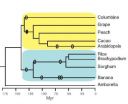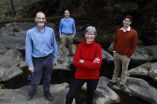(Press-News.org) Tropical Cyclone Hellen made landfall in west central Madagascar as NASA's Aqua satellite passed overhead capturing temperature data on its towering thunderstorms.
When NASA's Aqua satellite passed over Madagascar on March 31 at 10:47 UTC/6:47 a.m. EDT and the Atmospheric Infrared Sounder or AIRS instrument aboard captured infrared data on Hellen. AIRS data showed powerful thunderstorms circling the center of circulation with cloud top temperatures in excess of -63F/-52C indicating they were high into the troposphere. Thunderstorms reaching those heights also have the potential for heavy rainfall
Hellen developed during the week of March 23 in the Mozambique Channel, the body of water that lies between the island nation of Madagascar and Mozambique on the African mainland. By March 26, at 20:00 UTC/4 p.m. EDT, the tropical low, then known as System 95S was centered near 10.7 south latitude and 39.4 east longitude. The low level center was actually over land just inland from the coast, and sitting over the Tanzania and Mozambique border.
It was on March 26, that the Joint Typhoon Warning Center or JTWC noted that the low had a high chance for becoming a tropical depression in the next 24 hours. JTWC noted that enhanced infrared satellite imagery on March 26 revealed that the low-level circulation center has consolidated and there were bands of thunderstorms wrapping into it. JTWC estimated that maximum sustained winds are between 25 to 30 knots/ 28.7 to 34.5 mph/46.3 to 55.5 kph.
At that time, the tropical low was in an area that had low vertical wind shear and warm sea surface temperatures that forecasters at JTWC said would provide the fuel for thunderstorms to develop and assist the low's growth. Over the next several days, System 95S moved east and back into the Mozambique Channel where it rapidly intensified into Tropical Cyclone Hellen and reached Category IV status on the Saffir-Simpson Scale when maximum sustained winds peaked near 140 knots/161.1 mph/259.3 kph.
By March 31 at 1500 UTC/11 a.m. EDT, Hellen's maximum sustained winds dropped to 85 knots/97.8 mph/ 157.4 kph because of the interaction with Madagascar. It was centered near 16.2 south latitude and 45.9 east longitude, about 180 nautical miles/207.1 miles/333.4 km north-northwest of Antananarivo, Madagascar.
The NOAA-19 satellite showed that the bulk of strongest thunderstorms were south of the center as a result of wind shear. In addition there is dry air moving into the center of circulation which is also helping to weaken Hellen.
Hellen was moving slowly to the south-southeast at 5 knots/5.7 mph/9.2 kph, and the JWTC expects it to curve to the southwest and re-enter the Mozambique Channel.
INFORMATION:Text credit: Rob Gutro
NASA's Goddard Space Flight Center
Tropical Cyclone Hellen makes landfall in Madagascar
2014-03-31
ELSE PRESS RELEASES FROM THIS DATE:
Urban gardeners may be unaware of how best to manage contaminants in soil
2014-03-31
Consuming foods grown in urban gardens may offer a variety of health benefits, but a lack of knowledge about the soil used for planting, could pose a health threat for both consumers and gardeners. In a new study from the Johns Hopkins Center for a Livable Future (CLF), researchers identified a range of factors and challenges related to the perceived risk of soil contamination among urban community gardeners and found a need for clear and concise information on how best to prevent and manage soil contamination. The results are featured online in PLOS ONE .
"While the ...
New functions for 'junk' DNA?
2014-03-31
DNA is the molecule that encodes the genetic instructions enabling a cell to produce the thousands of proteins it typically needs. The linear sequence of the A, T, C, and G bases in what is called coding DNA determines the particular protein that a short segment of DNA, known as a gene, will encode. But in many organisms, there is much more DNA in a cell than is needed to code for all the necessary proteins. This non-coding DNA was often referred to as "junk" DNA because it seemed unnecessary. But in retrospect, we did not yet understand the function of these seemingly ...
Hybrid vehicles more fuel efficient in India, China than in US
2014-03-31
What makes cities in India and China so frustrating to drive in—heavy traffic, aggressive driving style, few freeways—makes them ideal for saving fuel with hybrid vehicles, according to new research by scientists at the U.S. Department of Energy's Lawrence Berkeley National Laboratory (Berkeley Lab). In a pair of studies using real-world driving conditions, they found that hybrid cars are significantly more fuel-efficient in India and China than they are in the United States.
These findings could have an important impact in countries that are on the brink of experiencing ...
Behind the scenes of the IPCC report, with Stanford scientists
2014-03-31
In the summer of 2009, Stanford Professor Chris Field embarked on a task of urgent global importance.
Field had been tapped to assemble hundreds of climate scientists to dig through 12,000 scientific papers concerning the current impacts of climate change and its causes.
The team, Working Group II, would ultimately produce a 2,000-page report as part of a massive, three-part U.N. Intergovernmental Panel on Climate Change (IPCC) Fifth Assessment Report, which details a consensus view on the current state and fate of the world's climate.
The job would take nearly five ...
USC Viterbi researchers developing cheap, better-performing lithium-ion batteries
2014-03-31
Researchers at the USC Viterbi School of Engineering have improved the performance and capacity of lithium batteries by developing better-performing, cheaper materials for use in anodes and cathodes (negative and positive electrodes, respectively).
Lithium-ion batteries are a popular type of rechargeable battery commonly found in portable electronics and electric or hybrid cars. Traditionally, lithium-ion batteries contain a graphite anode, but silicon has recently emerged as a promising anode substitute because it is the second most abundant element on earth and has ...
New non-surgical treatment for common, vexing eye condition
2014-03-31
Baltimore, MD, 31 March 2014. – A new report reveals a potential breakthrough in the treatment of a common eye ailment known as pterygium (Surfer's eye) that impacts the vision, eye health, and cosmetic appearance of countless sufferers.
The newly published report shows that eye drops containing the anti-anginal drug dipyridamole (Persantin®, Cardoxin®) led to almost total disappearance of an inflamed pterygium in a 35 year old otherwise healthy woman.
Dipyridamole is a drug in use over the past 55 years to treat other disorders, but now found to have this remarkable ...
Lowering your cholesterol may improve your sex life
2014-03-31
A new Rutgers study is giving hope to older men concerned about the effects of cholesterol-lowering medications on their sexual health.
The research, conducted at Rutgers Robert Wood Johnson Medical School, found that statin medication prescribed to lower cholesterol and decrease the chance of heart attack and stroke, also improves a man's erectile function. The researchers reported their findings at the American College of Cardiology's annual scientific session in Washington DC March 29 and in the April issue of The Journal of Sexual Medicine.
"Older men who have poor ...
Genetic cause of heart valve defects
2014-03-31
Heart valve defects are a common cause of death in newborns. Scientists at the University of Bonn and the caesar research center have discovered "Creld1" is a key gene for the development of heart valves in mice. The researchers were able to show that a similar Creld1 gene found in humans functions via the same signaling pathway as in the mouse. This discovery is an important step forward in the molecular understanding of the pathogenesis of heart valve defects. The findings have been published in the journal "Developmental Cell".
Atrioventricular septal defect (AVSD) ...
Satellite shows high productivity from US corn belt
2014-03-31
Data from satellite sensors show that during the Northern Hemisphere's growing season, the Midwest region of the United States boasts more photosynthetic activity than any other spot on Earth, according to NASA and university scientists.
Healthy plants convert light to energy via photosynthesis, but chlorophyll also emits a fraction of absorbed light as fluorescent glow that is invisible to the naked eye. The magnitude of the glow is an excellent indicator of the amount of photosynthesis, or gross productivity, of plants in a given region.
Research in 2013 led by Joanna ...
Nearly 97 percent of health professionals wash their hands when patients are asked to watch: Study
2014-03-31
TORONTO, ON, March 31, 2014 --
Improving hand hygiene compliance by healthcare professionals is no easy task, but a first-of-its-kind Canadian study by researchers at Women's College Hospital shows simply asking patients to audit their healthcare professional is yielding high marks.
The study, published in the April edition of the American Journal of Infection Control, details the findings of an 11-month pilot project looking at an alternative method of hand hygiene auditing using the patient-as-observer approach. In this method, patients observe and record hand hygiene ...





